Do you teach phonics in a small group setting? Or are you thinking of starting small groups, but you’re not sure how to get going?
In this post, I’ll share why I teach word study (sometimes referred to as phonics or spelling) in a small group setting. I’ll also share tips and possible schedules for setting it all up—because sometimes the logistics can be tricky!!
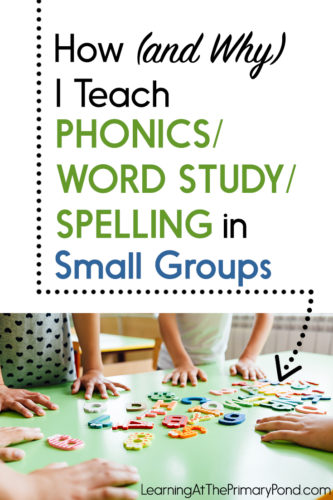
Photo Credit; kikovic, Shutterstock
Note: You’ll see me refer to “word study” throughout this post; I’m referring to phonics and spelling instruction too. The reason I call it “word study” is because I want the kids to learn phonics and spelling patterns AND the meaning of words. Word study can include vocabulary instruction too.
Another note: If you teach kindergarten, definitely read through the entire post, but know that I specifically address your needs in the last part!
Why would I teach word study in a small group setting?
Research and my own experience confirm that students are most successful learning about words when the instruction is differentiated to meet their specific needs!
I don’t know about you, but I’ve never taught a class of students who were ALL at the same level. Teaching word study in a small group setting allows us to differentiate and meet students’ specific needs. We want to target students’ zones of proximal development (Vygotsky), so we teach them concepts they haven’t yet mastered but can learn with our support.
Additionally, working with a small group just helps us provide more individualized attention than does working with the entire class at once.
If I teach word study in small groups, won’t I be providing word study instruction less often to each student than if I taught it whole group?
Yes and no. First of all, it will be more targeted instruction, so it will likely serve students much better (quality over quantity). Second, although I teach word study in a small group setting, I also discuss phonics concepts in whole group (i.e. during shared reading or writing). Additionally, we do a little bit of word work in guided reading.
Basically, small group instruction is one focused opportunity to teach these skills, but by no means does it have to be the only time in the day when students get this type of instruction.
How can I form groups for word study?
The first thing you’ll want to do is assess your students. You want to find out what word features they have mastered, and which features they still need to work on (i.e., they may have mastered short vowels, but can’t spell many words with long vowels correctly).
My favorite way to assess students is with a Words Their Way spelling inventory (Here’s an Amazon affiliate link for the Words Their Way book: http://amzn.to/2GB6U9B).
A spelling inventory is basically a carefully-designed spelling test. The words progress from easier to more difficult, so you can see which features students are comfortable with, as well as which features students still need to work on. For example, students might have an opportunity to spell simple CVC words, as well as CCVC words, so that you can see if they’ve mastered both CVC words and words with short vowels + beginning blends or digraphs.
If you don’t use the Words Their Way spelling inventory, there are other options! You can search online for the Kindergarten Spelling Inventory, McGuffey Spelling Inventory, or Viise’s Word Feature Inventory.
Once you’ve given the spelling inventory, you’ll need to analyze students’ results. The Words Their Way inventory guides you in determining which stage of development each student “falls” into. Then, you can group together students who are in the same or similar stages.
When you’re making groups, keep in mind that having 10 different word study groups in your classroom probably won’t lead to effective instruction! You’ll be too rushed to spend much time with any of your groups.
If you end up with 3-5 groups in your classroom, I think that’s definitely manageable.
If you have to place students from different stages into the same group, it’s not the end of the world. Students will still benefit from instruction that is closer to their level than one-size-fits-all, whole-group instruction would be.
Plus, you can still differentiate within a single group. Maybe you teach one lesson to that group, but then some kids in the group work with one set of words, and the other kids work with a slightly different set.
If you have a student who is WAY ahead or behind, consider talking to your other grade level team members. Maybe they have students at similar levels, and you can collaborate to group these kiddos together.
How can I set up a small-group word study schedule that works?
It seems like there’s never enough hours in the day, right?! If you’re worried that teaching phonics in a small-group setting will mess up your daily schedule, here are a few different suggestions and ideas. Hopefully you’ll find at least one strategy that works for your schedule! (Note that I don’t try to see every small group every day—that would definitely take up too much time!)
Option 1: Set aside 15 minutes for word study each day. See 1 group per day.
This option is my personal favorite strategy! Each day, you dedicate 15 minutes for word study (or more, if you have it). You work with one of your groups, and the other groups complete independent word study activities.
If you set things up this way, you probably won’t use the typical “introduce words on Monday” and “test on Friday” schedule. Instead, you’ll want to stagger students’ word work schedules. (I originally got this idea from the Words Their Way book – see my citations list at the end of the post – and tweaked it to meet my needs!)
Students will all rotate through these sessions:
- Session 1 (Teacher Introduction): In a small group setting, you meet with students. You teach them about a spelling pattern(s), introduce words for the week, and discuss the MEANING of the words. Assuming students will be sorting the words (which I recommend), you do the word sort for the week as a group.
- Session 2 (Re-Sorting & Writing): Students work independently to re-sort their words. They record their words by putting the sort on paper (not just copying the words, but writing them into their categories).
- Session 3 (Some Other Type of Sort): Students can do a different type of sort. For example, they might do a blind sort, where a partner reads them their words. Without seeing the words, they write the words down (into columns, based upon the word categories they learned in Session 1). Another option is to have students do a speed sort. They read and sort their words, timing themselves to see how quickly they can finish—and trying to beat their best time. The Words Their Way book has many different suggestions for sorts you can do. (You can also flip the order of sessions 2 and 3, if you find that your kids do better with partner support the first time they work without teacher support.)
- Session 4 (Games / In-Context Practice): Students play a game with their words and/or search for their words in books in their book bags.
- Session 5 (Spelling Test): Students are tested on their words; I recommend having them sort the words as they write them AND having them spell additional words to see if they can apply the pattern to new words. Session 5 can be another teacher session, but it doesn’t have to be. Maybe you have a parent volunteer or aide who handles this. Or maybe you create a voice recording of the words (with long pauses in between words), and students listen to the recording to take their spelling test.
Again, if you use a staggered schedule, not all students are on the same session each day.
Let’s say that you have 4 different word study groups in your class, and you have an aide or you use technology so that you don’t have to be available to give the test. (I really recommend that you find a way to do this, because it makes things much less complicated!) Your schedule might look something like this:

In this arrangement, you are seeing each group on their “blue days” to introduce the sort. This setup is nice because on Fridays, you are available to support groups with their independent work. You could even bring a group back for another teacher-led session, which is especially helpful for lower students.
However, let’s say you have 3 word study groups in your class. Your schedule would then look something like this. You would be occupied during the “blue” sessions, and then have Thursdays and Fridays free to pull additional groups:
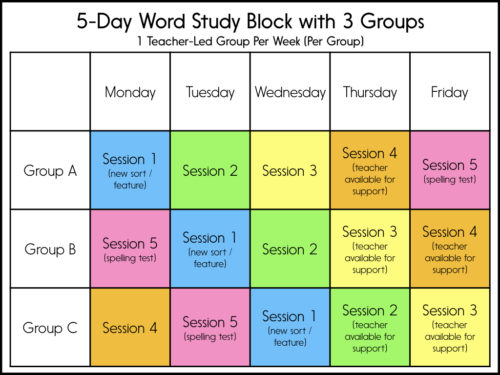
Last but not least, let’s look at a schedule with 5 total groups. In this case, you are only available to see each group once per week (to introduce the words/sort):
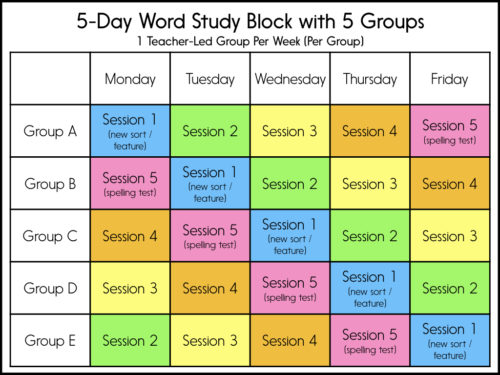
Remember, all of these schedules rely on you not needing to be available to give the spelling test. (If you do need to personally give the spelling test, I would recommend trying Option 2, which I’ll describe in a second.)
With any of these schedules, if you miss a day due to a holiday or snow day, simply pick up where you left off. The day of the week is not as important as the session number is.
To download these sample schedules, please put your information in below, and I’ll send them straight to your inbox!
Success! Now check your email to confirm your subscription.
Option 2: Set aside longer chunks of time on Monday and Friday, then have students complete word work activities during centers / Daily 5.
In this scenario, you don’t have to set aside time for word study every day; you carve out time on Mondays and Fridays, and then students practice their words as part of an independent work routine you already have in place (literacy centers, Daily 5, etc.).
On Mondays, you might set aside 45 minutes. You see each of your 3 groups for a 15-minute session. You introduce the pattern and words for the week during that lesson. (Meanwhile, the other children work on independent literacy activities. You could have a longer centers / Daily 5 period on Mondays, or see fewer guided reading groups to compensate.)
Tuesdays through Thursdays, students practice the words that you gave them on Monday. Each group has their own set of words, so their practice is differentiated. They can do different types of word sorts or play games with the words. If you have my first grade or second grade word work centers, then you have plenty of games that students can play with any words.
Then, on Fridays, you set aside another chunk of time to give students a spelling test on their words. You can do the test in small groups, or—I think I read this idea in Words Their Way—you can have kids sit in their word work groups (with privacy folders) and move around the classroom, giving each group a different word to write at the same time. I haven’t tried this, but it sounds efficient!
This option might be a good choice for you if you can’t squeeze in word study each day, but you have a little flexibility to make more time for it two days a week.
I’ve tried this strategy before, and the only drawback I saw was that Mondays can feel suuuuper long with having to get to all your groups. If you have more than 3-4 groups, this might not be workable for you!
Option 3: Teach your word study lessons during guided reading.
Although I prefer to separate guided reading and word study, it’s definitely possible to combine the two. This might be a good option for you if you have a BIG time crunch or very little flexibility in your schedule. Because students are already coming to you for guided reading, you wouldn’t have to adjust your schedule too much.
Normally, some guided reading lessons include a little bit of word work at the end of the lesson. If you were to combine word study instruction and guided reading instruction, you would want to make that ending time a bit longer.
Perhaps your guided reading lessons are 20 minutes rather than 15 minutes. Or maybe out of every 5 times you meet with a group, 1 or 2 of those sessions focuses mainly on word work.
However you do it, you’ll want to be intentional with setting up a schedule. Word work activities can easily “take over,” leaving little time for actual reading. Or, the opposite can happen: you’re teaching regular guided reading lessons and find that you only have a minute or two for phonics instruction.
Another word of caution: sometimes students’ development in phonics does not correspond to their guided reading level. Most of the time, students in a single guided reading group are more or less at the same word study level. But there are always exceptions.
Last year, for example, I was working with a little one who was reading at a Level B/C but needed word work activities I’d normally do with a Level F group! There were some other issues at play, but you get the picture—once in a while, you will have a mismatch between a guided reading level and a word study level.
(Note: The Words Their Way book has a chart that matches guided reading levels to word study levels.)
What if I teach Kindergarten?
Kindergarten is definitely a little bit different. 🙂
First, you’re probably not going to start the year teaching a ton of small groups. You may be able to squeeze them in here or there, but kids are still learning how to “do” school. It’s hard to get the entire class to work on something while you meet with a small group!
Second, many Kinders are not reading yet. You may address many word work-related skills in your guided reading or other small groups.
So….there are a number of considerations when you’re planning this out for Kinders! But research indicates that small-group instruction is definitely still worth your time:
- “[S]mall group differentiated instruction that is based on the letter names, letter sounds, and phonological awareness of children is likely to be more time-efficient and effective [than whole group instruction] in increasing letter knowledge.” (Stahl, 2014, p. 263)
- “Teachers get the best results when differentiating small-group instruction in response to the students’ existing alphabet knowledge.”(Stahl, 2014, p. 262)
Here’s how I like to run the year in Kinder:
- For the first 1.5-2 months of school, I introduce the alphabet letters in a whole group setting. We usually do 3-4 per week and also discuss letter formation. During this time, I also teach students how to complete picture sorts.
- Once the kids have been exposed to all the letters, I assess them to see what letters they know. I then form groups accordingly. (I focus on letter sound knowledge rather than letter name knowledge.)
- We continue our work with letters in a small-group setting. This usually takes place during guided reading, because they’re not doing a ton of actual reading yet. Additionally, students work on picture sorts and other hands-on activities during independent time.
- As the year goes on, I usually shift into a dedicated word work block with one of the schedules from Option 1. The activities may be a bit different, however, since some kids are still working on letters and others are working with simple words. Picture sorts and hands-on activities continue to be an important part of our letter/word work, although some kids do progress to regular word sorts.
Conclusions
Could any of these ideas work for you? Or do you have a different schedule to share? Please leave a comment below!
Also, if you are looking for examples of what a complete daily schedule might look like, take a peek at these posts:
Some of the ideas about grouping come from the Words Their Way book:
Bear, D. R., Invernizzi, M., Templeton, S., & Johnston, F. (2015). Words Their Way: Word Study for Phonics, Vocabulary, and Spelling Instruction (6th ed.). Pearson.
Another resource I cited was:
Stahl, K. K. (2014). New insights about letter learning. Reading Teacher, 68(4), 261-265.
Make sure to check back each Saturday (through April 2018) for more word work posts and freebies!
Happy teaching!




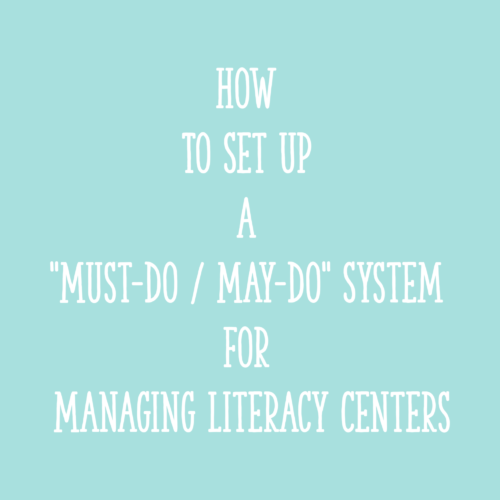
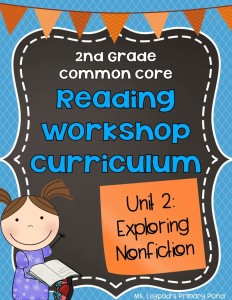
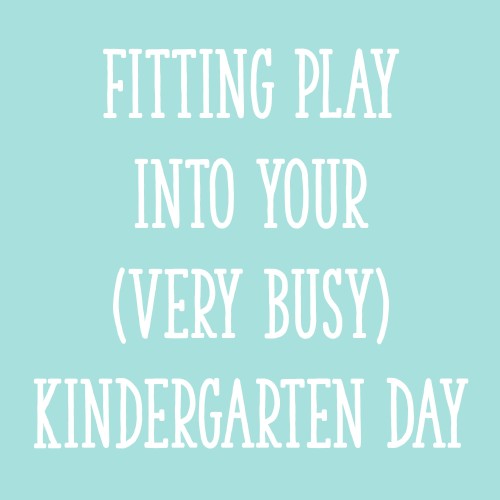






I LOVE the Option 1 schedule! You are a genius! I have been trying to figure out a schedule that works with my VERY LIMITED time for Language arts everyday. I had been trying to use a variation of Option 2 for years, but the crunch on Mondays and Fridays never worked for me. Knowing that I can have a daily schedule and stagger my groups is something I never thought of! Well, I had thought of it, but I didn’t know what to do on the other days! Thank you, again, for saving my schedule!
How do you feel about spelling city? I assign my kids a spelling list a week and they progress through the Words their Way lists. They work on activities within the app and then take a spelling test when they feel like they are ready. Do you feel this is developmentally appropriate for second grade? Just curious on your thoughts!
Hey Dronica! I know of Spelling City but haven’t actually used it myself. It’s basically just practice activities with the kids’ specific words, correct? It sounds a lot like what I was recommending here!
Alison
Thank you for this post! Your ideas about literacy are so clear cut and useful. How do you handle spelling tests and letting the parents know what the spelling words are and when the spelling tests are(Especially if the word study rotation changes because of short weeks)?
Hey Chloe! You can always make two copies of the list (or even a word sort page) for each child and send one home on whatever day each group receives it. If you do send it home and/or assign spelling homework, I would definitely explain how you do things to parents, since it can be a bit different from what many of them experienced in school!
Alison
Thank you for this! It is super helpful and has helped me sort out all the word study things going through my head. I do exactly the same thing as you but this year I couldn’t seem to get my head around it as I teach in a collaborative space this year with 2 other teachers. We each have 2-word study groups in which our whole cohort have been sorted using the words their way inventory. Which brings me to my question. How would you organise your session for 2 groups?
Hey Danielle! So glad it’s been helpful! I suppose I would just alternate between groups, seeing 1 every other day? You could see your lower group MWF and your higher group TR. Or you could have “A weeks” and “B weeks” to give the kids an equal number of opportunities to see you. You could still do the staggered schedule, but it would only be staggered in the sense that one group could get new words on Mondays and the other on Tuesdays.
I hope this helps!
Alison
Hi Alison,
Thanks for replying! I am so excited to start on Monday (we’ve spent the first few weeks of school introducing the activities and routines so they know how to do it all together and are independent when need be).
I have another question – perhaps I missed this? What to you have your other groups (the group not with you) doing if they finish their activity early?
Thanks,
Danielle
Hey Danielle! I try to structure activities so they are open-ended, but I also have games on-hand that they can play if there is a task with a defined finishing point. 🙂
Alison
Very useful information. I am very grateful. Thank you
Very useful information. I love teaching phonics and this has proven tobe very effective in helping students to read. I will be using some of these in my daily lessons.
As always, great ideas Allison! I’m in upper elementary and do the same for small-group word study…sometimes it’s tacked onto a guided reading lesson and sometimes just a small group mini-lessons. Similar to Option 3. So many times, I see word study not even addressed beyond 2nd-grade, and that’s such a mistake because most students haven’t developed a high-degree of automaticity in their word knowledge (both decoding and encoding). I’d like to add — in upper elementary, the whole group lesson is critical for efficiency, but it certainly doesn’t target misconceptions as well as small group, so a blended approach… Read more »
Thanks, Matt! I love hearing the upper elementary perspective from you – that’s not something I’m super experienced with, so I appreciate you sharing!
Alison